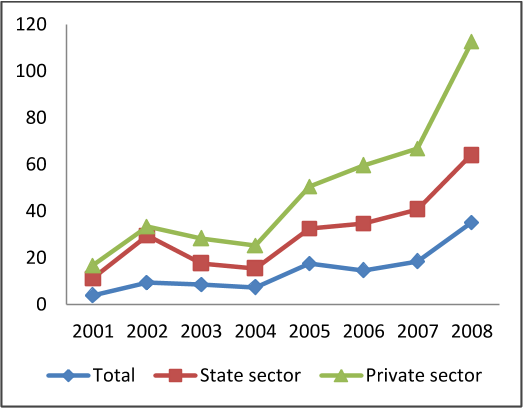




Did you find this useful? Give us your feedback










14 citations
13 citations
13 citations
12 citations
7 citations
...…2016; Aparicio et al., 2016; Havlicek et al., 2013) and the creation of innovational economy (Meelen et al., 2017; Rakhlis et al., 2016; Zhukovsrij et al., 2016; Santarelli and Tran, 2016; Leyden, 2016; Thalassinos and Liapis, 2014; Tyaglov et al., 2017; Liapis et al., 2013; Frank et al., 2016)....
[...]
..., 2013) and the creation of innovational economy (Meelen et al., 2017; Rakhlis et al., 2016; Zhukovsrij et al., 2016; Santarelli and Tran, 2016; Leyden, 2016; Thalassinos and Liapis, 2014; Tyaglov et al., 2017; Liapis et al., 2013; Frank et al., 2016)....
[...]
31,623 citations
...Firms that invest in R&D are likely to have superior economic performance, as R&D enables the development of new products/processes and absorptive capacity to effectively absorb knowledge from outside (Cohen and Levinthal, 1990)....
[...]
...…their unskilled counterparts are more capable to deal with the complexity of innovation (Song et al., 2003), more likely to absorb knowledge and consequently reinforce the absorptive capacity of a given organization (Cohen and Levinthal, 1990), and more successful in exploiting innovative ideas....
[...]
...This is consistent with Cohen and Levinthal (1990) in showing that technological capacity enables firms to absorb incoming spillovers and protect their own knowledge; (ii) both capital intensive and highly leveraged YICs are less profitable; (iii) firms operating in multi-business sectors and/or…...
[...]
..., 2003), more likely to absorb knowledge and consequently reinforce the absorptive capacity of a given organization (Cohen and Levinthal, 1990), and more successful in exploiting innovative ideas....
[...]
...absorptive capacity to effectively absorb knowledge from outside (Cohen and Levinthal, 1990)....
[...]
26,580 citations
...…test ( = 0.013 P-value = 0.907 12 Under-identification test ( Over-identification test (Hansen J statistic) ( 13 Extending the work of Arellano and Bond (1991), they propose a system estimator that uses moment conditions in which lagged differences are used as instruments for the…...
[...]
19,132 citations
18,200 citations
...Endogenous growth models (Romer, 1986) postulate that technological change stimulates economic growth if the return to innovation with respect to human capital used in the R&Dintensive sectors is constant....
[...]
...Conceptual framework Endogenous growth models (Romer, 1986) postulate that technological change stimulates...
[...]
6,008 citations